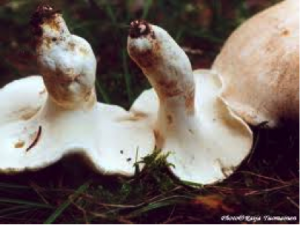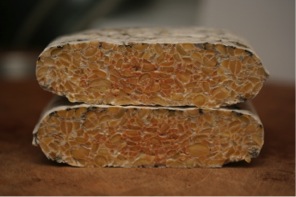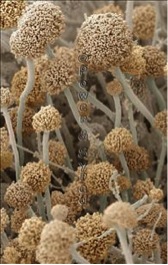By Marcus Goodman
Few things are pursued with such a broad spectrum of enthusiasm as gaining an understanding of the Kingdom Fungi. Loathed by as many as are enthralled by them, fungi in their fruiting form have an effect on some which can border on the maniacal. Some are intrigued by kingdom Fungi’s complexities which have enabled similar morphological traits to converge as well as separate across phyla. Others are more entranced by the mystical, spiritual and medical benefits. A quality alleged by some of the kingdom Fungi. Some just love the pretty colors; while others have more gastronomical hopes in mind. The latter is where my interest seems to be most prevalent, and it was in this pursuit I first encountered Albatrellus ovinus (Shaeff).
I was enjoying an extended season as a budding mycophagist in the Quinault Lake region of Washington State over Thanksgiving weekend. This region hadn’t yet experienced the fungi-fruit killing frosts experienced by most of western Washington earlier in November. Consequently, many fungi-fruiting bodies were in prime form for the picking—Hydnum repandum, Hydnum umbilicatum, Tricholoma magnivelare, Sparassis crispa, Hericium abietis, Craterellus tubaeformis, were just a few edible species present or abundant. I was on my way home from visiting a Western Red Cedar bog, a pretty rare biological community found in the Quinault area of the temperate rainforest, when I first noticed large white-buff-yellow fruiting bodies in the vicinity of old growth Tsuga heterophylla. At first, glance I almost walked right on by, potentially mistaking them for similar-looking Tricholomas I’ve had difficulty identifying this year. One thing I’ve learned with mushrooms: don’t assume anything, and if something catches your eye, don’t hesitate to investigate—you never know what you’ll find.
Here’s what I observed:
- Habitat: Old growth Tsuga heterophylla dominated forest. 85% canopy Gaultheria shallon, Polystichum munitum, Vaccinium ovatum dominant shrub/scrub Polytrichum spp., Kindbergia oregano, Holocomium splendens dominant groundcover
- Growth Habit: Scattered to gregarious
- Substrate: Humicolus. Minimal soils present. Specimens found in isolated soil/hummus. Potentially decomposed wood present
- General Characteristics: Cap:8-16 cm.white-to-buff-to-light yellow, convex to plane with decurved to uplifeted margin. Cap surface dry, smooth, slightly scaled towards center. Margin even and regular. Cap flesh white, firm, dry-to-slightly moist, no apparent bruising, taste or smell.
- Gills: Decurrent, pores, white-to-buff, smooth, minute
- Stem: 0.5-2.5 cm thick, 3-8 cm long. White-to-buff. Central, equal to slightly clavate surface smooth at base to porous at decurrent pores. No mycelium observed at base.
You can imagine, as someone intent on maximizing the culinary benefits of my mycelial friends, I was more than intrigued at this finding. If it wasn’t for a full foraging bag of other known delectables, I would have gathered some for the table. As it was, I gathered none—planning on coming back in the morning for further investigation and observation. This decision was one I would come to regret.
All best laid plans are usually just that. Plans. The reality was an obscured series of days, blurred by a food coma that rendered all hopes of activities more than 20 minutes beyond a suitable napping location simply futile. How many mushroom foraging hopes have been shattered by the ubiquitous turkey on the days following Thanksgiving?
During rare moments of lucidity, I was able, through semi-conscious keying sessions, to use the standard mushroom literature for the Pacific Northwest: Mushrooms Demystified (Arora, 1986) and Mushrooms of the Pacific Northwest (Trudell, Ammirati, 2009) to narrow the possibilities to genus Albatrellus, but without an actual specimen, the specific epithet proved elusive. Arora—the obligate mycophagist—declares (ovinus and associates) them edible when cooked well, but includes the disclaimer, “Large quantities can have laxative effects.” Ever creative with his descriptive terms, Arora uses—“okraceous”—for the flavor/texture/consistency. As usual, Trudell and Ammirati are silent on the matter. Although their general conclusion is our coastal specimens are A. avellaneus (Though not supported by Arora’s description) with A. ovinus apparently not occurring in our region. This inability to solidify the identity was further enabled as a result of the disproportionate napping activity.
However, after the weekend was over and I was back at home, I couldn’t stop thinking about the pale, firm, slightly moist, fleshy consistency of the one that got away. Absence definitely makes the heart grow fonder. What to do? Internet search time. Not a big fan of this, but there are a few locations with worthwhile and reliable information:
http://www.mushroomexpert.com/albatrellus_ovinus.html
http://www.mycobank.org/Biolomics.aspx?Table=Mycobank&MycoBankNr_=292351
Like all things in the fungal kingdom, nothing is ever easy. However, if this was “Mission Difficult,” anyone could do it and there’d be less mushrooms in the woods, right? It turns out, A. ovinus is a highly regarded mushroom in the Scandinavian region—specifically Finland. This excited me, since I come from Finnish decent. Unfortunately, I can’t roll my rr’s. Because of this my grandma refused to teach me any Finnish beyond numbers 1-10, and some miscellaneous body parts I won’t mention here. All I could do was look at the pictures and dream. I finally gathered questionable, boiler plate mushroom guidance from an array of sources not worth citing:
- Don’t consume A. ovinus with other mushrooms
- Cook A. ovinus well
- May cause a laxative effect
- Don’t eat raw
- May contain phenolic compounds (Dekermendjian, et al, 1997)
- Becomes bitter with age
- Slimy when cooked
- Blah, blah, blah
I know I should always treat mushrooms with respect, especially one that may contain phenolic compounds, which is a chemical compound found in plants and some fungi, but the above comments seem to contradict the apparent delectability of the genus in Scandinavia and Northern Europe. As I sit here and gaze dreamily at all of the Googled images of this mushroom, many about to, or being eaten, I can’t help but want to know more. By next fall I’ll either have to learn Finnish, or give Albatrellus ovinus a taste test. So it goes with the kingdom fungi.
References:
Arora, D. 1986. Mushrooms Demystified, Second Edition. Random House, Inc. New York.
Dekermendjian, K., Shan, R., Nielsen, M., Stadler, M., Sterner, O., Witt, M.R. 1997. The affinity to the brain dopamine D1 receptor in vitro of triprenyl phenols isolated from the fruit bodies of Albatrellus ovinus. European Journal of Medicinal Chemistry. Vol. 32, Issue 4, pgs. 351-356.
http://www.mushroomexpert.com/albatrellus_ovinus.html
http://www.mycobank.org/Biolomics.aspx?Table=Mycobank&MycoBankNr_=292351
Trudell, S., Ammirati, J.2009. Mushrooms of the Pacific Northwest. Timber Press, Inc. Portland OR.
Vrkoc, J., Budesinsky, M., Dolejs, L.1977. Phenolic meroterpenoids from the basidomycete Albatrellus ovinus. Phytochemistry.Vol 16, Issue, 9, pgs 14091411.






